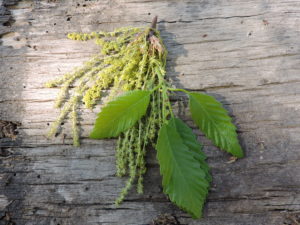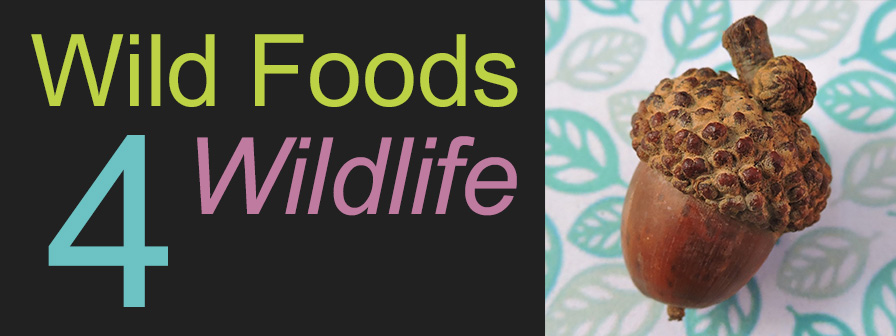
The list below ranks in order the top 75 favorite wildlife preferred browse. Browse is defined as small twigs, buds and leaves of woody trees, shrubs and vines, and occasionally bark.
The ranking is determined using two criteria to describe the role of the plant food in animals’ diets:
1) the number of species that utilizes the food,
2) how significant the food is within an individual species overall diet
So while a food may not be popular across a large number of species, it still could be strongly preferred by a few species. By coordinating with a rehabber’s specific needs, a forager can decide which plants to best target for collection.
Be sure to check any item listed below in the database to see if there are any toxicological warnings associated with that plant or part of the plant.
| Common Name | Botanical Name | Part Eaten | |
| 1 | oak | Quercus spp. | browse/bark |
| 2 | maple | Acer spp. | browse/bark |
| 3 | maple, box elder | Acer negundo | browse/bark |
| 4 | poison ivy, eastern | Toxicodendron radicans | browse/bark |
| 5 | aspen | Populus spp. | browse/bark |
| 6 | aspen, quaking | Populus tremuloides | browse/bark |
| 7 | blueberry | Vaccinium spp. | browse/bark |
| 8 | willow | Salix spp. | browse/bark |
| 9 | dogwood | Cornus spp. | browse/bark |
| 10 | hazelnut | Corylus spp. | browse/bark |
| 11 | elderberry | Sambucus spp. | browse/bark |
| 12 | pine | Pinus spp. | browse/bark |
| 13 | birch | Betula spp. | browse/bark |
| 14 | viburnum | Viburnum spp. | browse/bark |
| 15 | serviceberry | Amelanchier spp. | browse/bark |
| 16 | hazelnut, beaked | Corylus cornuta | browse/bark |
| 17 | blackberry | Rubus spp. | browse/bark |
| 18 | spruce | Picea spp. | browse/bark |
| 19 | maple, striped | Acer pensylvanicum | browse/bark |
| 20 | elm | Ulmus spp. | browse/bark |
| 21 | ash | Fraxinus spp. | browse/bark |
| 22 | hemlock | Tsuga spp. | browse/bark |
| 23 | fir | Abies spp. | browse/bark |
| 24 | dogwood, gray | Cornus racemosa | browse/bark |
| 25 | birch, paper (white birch) | Betula papyrifera | browse/bark |
| 26 | birch, yellow | Betula alleghaniensis | browse/bark |
| 27 | hawthorn | Crataegus spp. | browse/bark |
| 28 | sassafras | Sassafras albidum | browse/bark |
| 29 | dogwood, flowering | Cornus florida | browse/bark |
| 30 | blueberry, lowbush | Vaccinium angustifolium | browse/bark |
| 31 | birch, gray | Betula populifolia | browse/bark |
| 32 | bunchberry | Cornus canadensis | browse/bark |
| 33 | dogwood, red-osier | Cornus sericea | browse/bark |
| 34 | cottonwood, eastern | Populus deltoides | browse/bark |
| 35 | elder, red | Sambucus racemosa | browse/bark |
| 36 | mountain ash, American | Sorbus americana | browse/bark |
| 37 | sumac | Rhus spp. | browse/bark |
| 38 | basswood, American | Tilia americana | browse/bark |
| 39 | pine, white eastern | Pinus strobus | browse/bark |
| 40 | hickory | Carya spp. | browse/bark |
| 41 | white-cedar, northern (arborvitae) | Thuja occidentalis | browse/bark |
| 42 | fir, balsam | Abies balsamea | browse/bark |
| 43 | maple, mountain | Acer spicatum | browse/bark |
| 44 | poplar, balsam | Populus balsamifera | browse/bark |
| 45 | blackberry, Himalayan | Rubus armeniacus | browse/bark |
| 46 | mountain ash | Sorbus spp. | browse/bark |
| 47 | alder | Alnus spp. | browse/bark |
| 48 | sweet fern | Comptonia peregrina | browse/bark |
| 49 | hornbeam, American | Carpinus caroliniana | browse/bark |
| 50 | snowberry | Symphoricarpos spp. | browse/bark |
| 51 | rose | Rosa spp. | browse/bark |
| 52 | sweetgum | Liquidamber styraciflua | browse/bark |
| 53 | beech, American | Fagus grandifolia | browse/bark |
| 54 | squashberry | Viburnum edule | browse/bark |
| 55 | teaberry, eastern (wintergreen) | Gaultheria procumbens | browse/bark |
| 56 | ash, black | Fraxinus nigra | browse/bark |
| 57 | oak, white | Quercus alba | browse/bark |
| 58 | oak, northern red | Quercus rubra | browse/bark |
| 59 | sumac, staghorn | Rhus typhina | browse/bark |
| 60 | viburnum, mapleleaf | Viburnum acerifolium | browse/bark |
| 61 | dogwood, alternate-leaf | Cornus alternifolia | browse/bark |
| 62 | sweet bay | Magnolia virginiana | browse/bark |
| 63 | hackberry, common | Celtis occidentalis | browse/bark |
| 64 | hackberry | Celtis spp. | browse/bark |
| 65 | honeysuckle, Japanese | Lonicera japonica | browse/bark |
| 66 | pear | Pyrus spp. | browse/bark |
| 67 | ash, white | Fraxinus americana | browse/bark |
| 68 | witch hazel, American | Hamamelis virginiana | browse/bark |
| 69 | chokeberry | Aronia spp. | browse/bark |
| 70 | birch, sweet | Betula lenta | browse/bark |
| 71 | tamarack | Larix laricina | browse/bark |
| 72 | larch | Larix spp. | browse/bark |
| 73 | buckthorn | Rhamnus spp. | browse/bark |
| 74 | walnut, black | Juglans nigra | browse/bark |
| 75 | pawpaw | Asimina triloba | browse/bark |
What Criteria is Used for the Ranking the Lists?
The main resources used to build this website usually rated foods in three levels of preference: high, middle and low. But, a plant may be high preference in Michigan but lower preference in Virginia. So the preference factor has some built in limitations. Still, it is factor #1 in the algorithm.
The second factor considered was how many species of animals ate the part of the plant in consideration. A seed that 29 species ate would outrank a seed that only 5 species ate.
From a foragers perspective, it would be ideal to collect the most highly preferable foods that feed the widest range of rehabilitation animals, right? Well maybe not.
Consider if a rehabilitator only works with foxes? To research which foods would be most beneficial in the “fox only” scenario, the only consideration that she would care about is the most preferred food for foxes, not how many other species ate it.
So the ranking lists are the most general broad interpretation of the data. You will want to generate your own lists from the search feature to find out just what you want to target for collection.
References Used with Permission:
The Fire Effects Information System, U.S. Department of Agriculture, Forest Service, Rocky Mountain Research Station, Fire Sciences Laboratory (Producer).
Fire Effects Information System (2017) Plant species ecology literature reviews. Retrieved various dates from https://www.feis-crs.org/feis/
Martin, A.C., Zim, H.S., Nelson, A.L. (1951). American Wildlife and Plants: A Guide to Wildlife Food Habits. New York: Dover Publications.
Scott, M. (2013). Songbird Diet Index. National Wildlife Rehabilitators Association, St. Cloud, MN.
